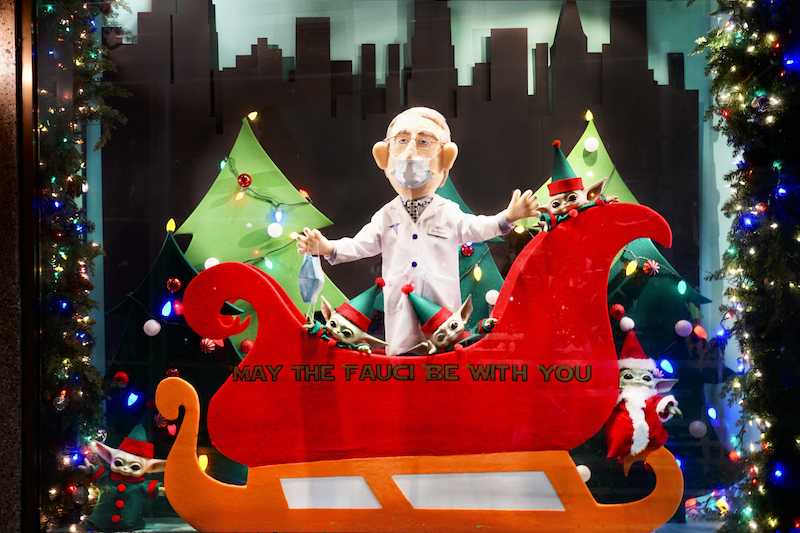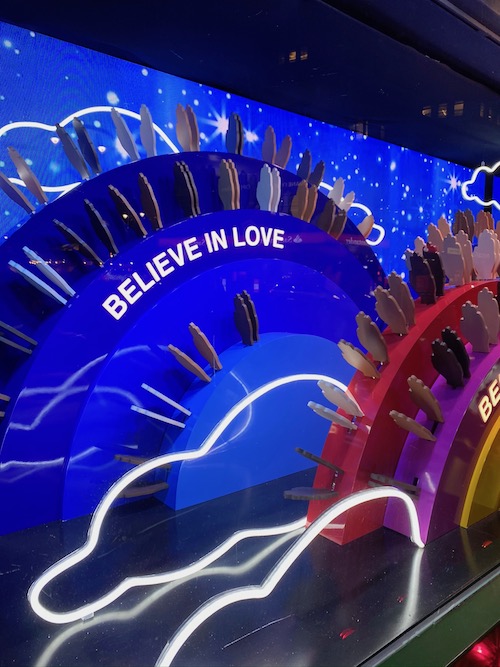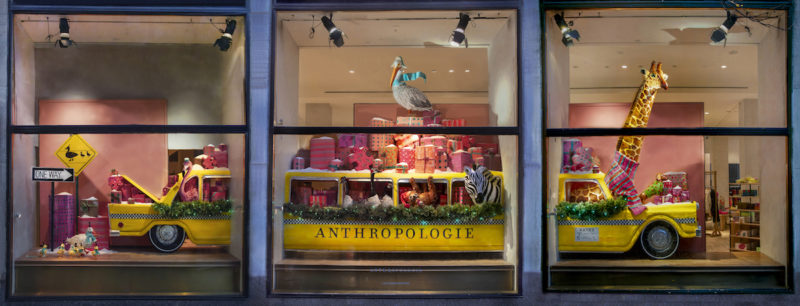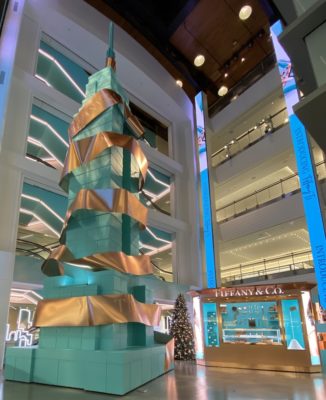
In the holiday window display at C.O. Bigelow Chemists in Greenwich Village, a Dr. Anthony Fauci figure greets customers from a sleigh, with the phrase “May the Fauci be with you” stuck to the glass. In this unprecedented year, marked by fear and loss, this clever reference to the public health leader (and hero to many) has offered levity for weary locals.
Amy Henry, Visual Presentation and Exhibition Design (VPED) ’97, who has designed the apothecary’s windows for the past 15 years, created the display to celebrate the health care workers who put their lives at risk this year.

“It’s been such a weird year in so many ways, and so many people have been affected,” says Henry, a freelance set and production designer for photo shoots and videos. “We were trying to do something cool that would get people to smile.”
In a year of upheaval and uncertainty, holiday window displays bring a welcome dose of cheer. This year, it seems that the pandemic has pushed retailers to make them better.
“The quality of windows is really fantastic this year,” says Anne Kong, associate professor of VPED. “There were a lot of tactile elements that sent warm messaging virtues: gratitude, strength, equality, justice, and diversity.”
Macy’s, for example, presented mechanical clapping hands thanking essential workers and the city of New York. Saks Fifth Avenue depicted scenes of New Yorkers adapting to social distancing. To brighten empty storefronts, the city installed light-up sculptures on the sidewalk.
Craig Berger, associate professor and program coordinator of VPED, believes more money will be spent on holiday displays this year than in any previous year.
“Retailers and product manufacturers are going to try to get visibility at an even higher level than before, and they’re going to reach beyond the window. I don’t believe a singular display is enough anymore.”
Berger, who writes reports on retail display and other visuals for the Sign Research Foundation, adds, “The misconception is that because of COVID-19, people don’t spend money. That’s not the case. What they do is reapportion the dollars they have.”
While window displays can beckon shoppers into stores, Kong says that the primary purpose of holiday window displays is to generate goodwill.
“We never look at holiday windows as a vehicle to gain revenue for the store,” she says. “They’re always a gift back to the city, and this year more than ever.”
Cute Overload
Animals figured prominently in many of New York’s displays, according to Kong. The reason, she believes, is that “Animals came to people’s rescue in this time of need. People purchased and adopted pets more than ever.”
For example, the windows at Anthropologie’s Rockefeller Center store house a menagerie of adorable papier-mâché animals—ducklings, a flamingo, zebra, giraffe, and more—delivering gifts from an 18-foot taxi that stretches across three windows.

“The company directive was ‘animals bringing gifts,’” says Kate Krabel, Fine Arts ’12, a display coordinator at the store who sculpted all 26 animals by hand. “Our store has the biggest budget [among Anthropologie locations] and the biggest leeway to diverge from the concept. We decided to do something iconic to the city that will make our customer smile—a classic old-school taxi.”
It’s no coincidence that the holiday display is more stunning this year than ever, Krabel says. Though the size of the construction team was limited as a safety precaution, the company focused its resources on the windows, because of the increased challenge of drawing customers into stores this year.
Simplicity, Inside and Out
At Tiffany & Co., holiday window designs for all 300-plus stores worldwide were completed in March, before the pandemic, but the simple, joyful aesthetic is a fitting message this tumultuous year, says Emma Pawlukojc Morgan, VPED ’12.
As a design director on Tiffany’s global creative visual merchandising team, Morgan focuses on in-store displays both for the company as a whole and the Fifth Avenue flagship. But she also coordinates with the window teams to ensure a unified look.
The window concept is luxury metals, with a palette of Tiffany blue and rose gold. “We wanted this very liquid and sumptuous reflective quality in all of the windows,” Morgan says.
The pared-down window designs (above) focused on a single prop, highlighted in a metallic display. In one of the five window templates provided to all stores, the jewels are displayed in a pile of white powder poured from a box labeled “display snow.” In another, rings and bracelets are featured on a simple metal tree shape that seems to be melting into a puddle.
For customers who couldn’t see the windows in person this year, the company shared short videos on Instagram.
Morgan emphasizes that windows are still important this year. “Even in Asia, the foot traffic is on an uptick. People are out there and still wanting to shop—just in a different way.”

The pandemic affected the in-store displays more than the windows. Normally, Tiffany & Co. offers an interactive bit of hospitality for customers, like last year’s cocoa bar. This year, to maintain appropriate distance, interactive elements were withheld in favor of moments for solo discovery, like columns clad in rose gold and a 40-foot Empire State Building built from blue boxes and wrapped in a 250-foot gold ribbon. The store is occupying an adjacent space while the flagship is being renovated.
“The overall warmth and festive, shiny quality have been bringing a smile to everyone’s face,” Morgan says. “People are eager to see something that feels normal, so we didn’t pull back from what we would typically do, just modified it in line with safety requirements.”










